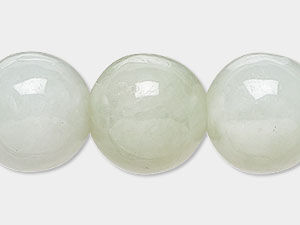Jade, Jadeite Meaning and Properties
Jadeite History
Jadeite is one of two forms of jade. This beautiful gem is loved in jewelry for its striking green color, but jadeite gemstones were originally used thousands of years ago as weapons. Jade's toughness made it ideal for carving into axe heads and tools as well as ritual artifacts. It didn't take long before ancient civilizations noticed jadeite not only for its durability, but also its beauty and potential metaphysical capabilities. Central American cultures would sometimes hold jadeite against their sides to help cure ailments, which is why the Spanish called jadeite "piedra de ijada," meaning "stone for the pain in the side." On the other side of the world, the Chinese called jade "yu," meaning "heavenly" or "imperial," and it has been found in the tombs of some Shang dynasty kings and other important figures. Lady Fu Hao's tomb contained 755 jade objects!
What are the Metaphysical Properties of Jadeite?
The Chinese especially valued jadeite and have used the gemstone for multiple purposes. First, jadeite gems are said to possess health-strengthening abilities and improve longevity. Jadeite bangle bracelets are said to protect the wearer and absorb negative energy. According to feng shui, jadeite jade meaning is linked not only to health, but to prosperity. Considered a "dream stone" by ancient cultures, jade is used today to dream solve, access the spiritual realm and encourage creativity.
What is Jadeite Made From?
There is more than one type of jade, but only two pure jades: nephrite and jadeite. Jadeite is the more uncommon of the two and for that reason, and for its more vitreous luster, it is considered more valuable. Jadeite is a sodium-rich pyroxene mineral that is formed by fine-grained interlocking crystals in metamorphic rocks under high pressure, but low temperatures. Pure jadeite is actually white, but the prized green hue is a result of chromium impurities. High-grade emerald-green jadeite is commonly called "Imperial Jade" and is quite rare. Burma is the main source of jadeite, including Imperial Jade. Other sources include Japan, Canada, Guatemala, Kazakhstan, Russia, Turkey, Cuba and the United States.
|
|
|
|
|
|
|
|
|
|
|
|
|
|
|
|
|
|
How Do You Clean Jadeite?
Jade stones may have been known for their toughness, but the surface is still able to be scratched. The best method of cleaning jadeite is to use a soft cloth dipped in soapy water. Jadeite is also porous, so it's best to avoid submerging the stone completely in the soapy water. Make sure the jadeite, as well as the rest of the jewelry piece, is completely dry before storing. Do not use steam or ultrasonic cleaners.
Jadeite FAQ
Q: Is jadeite jade really jade gemstone?
A: Jadeite jade is true jade, and is considered more valuable than the other true jade, nephrite jade.
Q: What distinguishes jadeite from other types of jade, like nephrite?
A: Nephrite jade and jadeite jade are the two types of genuine jade. Chemically, they are very different—a fact that wasn’t discovered until 1863! Before then, they were thought to be the same substance. Both come in a variety of colors—jadeite in shades of green, pink, lavender, white and blue, and nephrite in greens, black, white and yellow. Jadeite is slightly harder than nephrite, with a Mohs hardness of 6-1/2 to 7 compared to nephrite’s 6 to 6-1/2. Jadeite is rare—most jade sold today is the nephrite variety.
Q: How rare and valuable is jadeite compared to other jade varieties?
A: Jadeite is much rarer and more valuable than nephrite jade.
Q: How do you identify genuine jadeite from imitations?
A: Genuine jadeite will have small imperfections—inclusions of grains and/or fibers. True jade is also heavier than most varieties of imitation jade. Some common materials passed off as jade include chrysoprase, serpentine, prehnite, aventurine and marble. For your convenience, Fire Mountain Gems and Beads distinguishes true jade from genuine jade by the use of quotation marks around the word “jade” on imitation varieties.
Designing with Jadeite
While jadeite is mostly known for being green, jadeite colors can range from green, white, yellow, grey, pinkish and more, which means you have quite a palette to design with. Combine light-colored jadeite beads with warmer colors to create a cooling effect. On the color wheel, green hues are complementary to reds and purples while analogous to yellows and oranges.
Shop for Jadeite
**Please note that all metaphysical or healing properties listed are collected from various sources. This information is offered as a service and not meant to treat medical conditions. Fire Mountain Gems and Beads® does not guarantee the validity of any of these statements.
How did you like this resource? Your feedback helps us provide resources that matter to you most.
Copyright Permissions
All works of authorship (articles, videos, tutorials and other creative works) are from the Fire Mountain Gems and Beads® Collection, and permission to copy is granted for non-commercial educational purposes only. All other reproduction requires written permission. For more information, please email copyrightpermission@firemtn.com.

